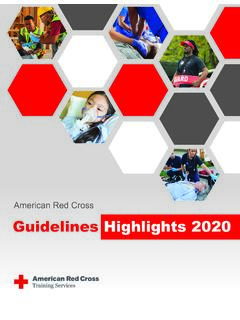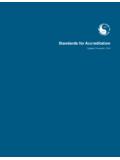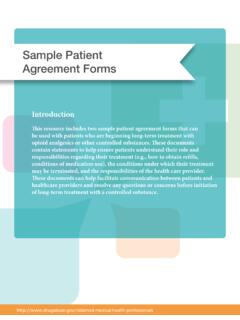Transcription of PART I INTRODUCTION - American Council on Exercise
1 PART I. INTRODUCTION . CHAPTER 1. ROLE AND SCOPE OF PRACTICE. FOR THE PERSONAL TRAINER. 1. CHAPTER. ROLE AND SCOPE OF PRACTICE FOR THE. PERSONAL TRAINER. TODD GALATI. IN THIS CHAPTER: The Allied Healthcare Continuum The ACE Personal Trainer Certification Defining Scope of Practice . Scope of Practice for ACE. Certified Personal Trainers Knowledge, Skills, and Abilities of the ACE Certified Personal Trainer Professional Responsibilities and Ethics Accreditation of Allied Healthcare Credentials Through the NCCA. Recognition From the Fitness and Health Industry Recognition From the Education Community Recognition From the Department of Labor THE BENEFITS RESULTING FROM REGULAR PHYSICAL ACTIVITY ARE. well documented (Table 1-1). After a comprehensive review of the research linking Career Development physical activity to health, the Department of Health & Human Services Continuing Education Degrees (2008) released the 2008 Physical Activity Guidelines for Americans, the first Additional Fitness comprehensive guidelines on physical activity to be issued by the government.
2 Certifications These guidelines list the following major research findings regarding physical New Areas of Expertise Within activity and its associated health benefits: Allied Healthcare Regular physical activity reduces the risk of many adverse health outcomes. Summary Some physical activity is better than none. For most health outcomes, additional benefits occur as the amount of physical activity increases through higher intensity, greater frequency, and/or longer duration. Most health benefits occur with at least 150 minutes a week of moderate- intensity physical activity, such as brisk walking. Additional benefits occur with more physical activity. TODD GALATI, , is the director of credentialing for the American Council on Exercise . He holds a bachelor's degree in athletic training, a master's degree in kinesiology, and four ACE certifications (Advanced Health &. Fitness Specialist, Personal Trainer, Health Coach, and Group Fitness Instructor).
3 Prior to joining ACE, Galati was a program director with the University of California, San Diego School of medicine , where he researched the effectiveness of youth fitness programs in reducing risk for cardiovascular disease, obesity, and type 2 diabetes. Galati's experience includes teaching biomechanics, applied kinesiology, and anatomy classes at Cal State San Marcos and San Diego State University, working as a research physiologist with the Navy, personal training in medical fitness facilities, and coaching endurance athletes. ACE PERSONAL TRAINER MANUAL | ROLE AND SCOPE OF PRACTICE FOR THE PERSONAL TRAINER CHAPTER 1 3. Both aerobic (endurance) and muscle-strengthening (resistance) physical activity are beneficial. Health benefits occur for children and adolescents, young and middle-aged adults, older adults, and those in every studied racial and ethnic group. The health benefits of physical activity occur for people with disabilities.
4 The benefits of physical activity far outweigh the possibility of adverse outcomes. Table 1-1. Health Benefits Associated With Regular Physical Activity Children and Adolescents Strong evidence Moderate evidence Improved cardiorespiratory and muscular fitness Reduced symptoms of Improved bone health depression Improved cardiovascular and metabolic health biomarkers Favorable body composition Adults and Older Adults Strong evidence Moderate to strong evidence Lower risk of early death Better functional health Lower risk of coronary heart disease (for older adults). Lower risk of stroke Reduced abdominal obesity Lower risk of high blood pressure Lower risk of adverse blood lipid profile Moderate evidence Lower risk of hip fracture Lower risk of type 2 diabetes Lower risk of lung cancer Lower risk of metabolic syndrome Lower risk of endometrial Lower risk of colon cancer cancer Lower risk of breast cancer Weight maintenance after Prevention of weight gain weight loss Weight loss, particularly when combined with Increased bone density reduced calorie intake Improved sleep quality Improved cardiorespiratory and muscular fitness Prevention of falls Reduced symptoms of depression Better cognitive function (for older adults).
5 Department of Health & Human Services (2008). 2008 Physical Activity Guidelines for Americans: Be Active, Healthy and Happy. Note: The Advisory Committee rated the evidence of health benefits of physical activity as strong, moderate, or weak. To do so, the Committee considered the type, number, and quality of studies available, as well as consistency of findings across studies that addressed each outcome. The Committee also considered evidence for causality and dose response in assigning the strength-of- evidence rating. 4 CHAPTER 1 ROLE AND SCOPE OF PRACTICE FOR THE PERSONAL TRAINER | ACE PERSONAL TRAINER MANUAL. These findings reinforce what fitness professionals have known for years: The human body was meant to move and, when it does so with regularity, it responds to the stress of physical movement with improved fitness and health. Guidelines with similar goals and recommendations have been published in the past by the American College of Sports medicine (ACSM) and American Heart Association (AHA) (Haskell et al.)
6 , 2007), Department of Agriculture (USDA) (2010), International Association for the Study of Obesity (Saris et al., 2003), Institute of medicine (2002), and the Department of Health & Human Services (1996). The 2008 guidelines from the Department THE NEED FOR PERSONAL. of Health & Human Services mark the the first time the government had enough TRAINERS TO HELP available research to make the claim that all Americans should engage in regular physical COMBAT THE RISING activity to improve overall health and to reduce the risk of many health problems.. OBESITY EPIDEMIC Even with well-established guidelines for physical activity, the majority of HAS LED TO A healthcare professionals have little or no formal education or practical experience POSITIVE OUTLOOK FOR in designing and leading Exercise programs. Physicians often give patients PERSONAL TRAINING recommendations to Exercise , but they generally do not provide specific instructions AS A PROFESSION for how to Exercise .
7 ACE Certified Personal Trainers, therefore, play a vital role in allied healthcare by providing services that help clients participate in effective Exercise programs that result in positive health and fitness improvements. In the past, personal trainers have primarily worked with fitness enthusiasts in traditional fitness facilities. This role is changing due to the increasing number of adults and children who are overweight or obese and have related health issues. Personal trainers must now be prepared to work with clients ranging in age from youth to older adults, and ranging in health and fitness status from sedentary to athletic. The need for personal trainers to help combat the rising obesity epidemic has led to a positive outlook for personal training as a profession. THE ALLIED HEALTHCARE CONTINUUM. THE ALLIED HEALTHCARE CONTINUUM IS COMPOSED OF HEALTH PROFESSIONALS. who are credentialed through certifications, registrations, and/or licensure and provide services to identify, prevent, and treat diseases and disorders.
8 Physicians are at the top of the healthcare pyramid, evaluating patients to diagnose ailments and implement treatment plans that can include medication, surgery, rehabilitation, or other actions. Physicians are assisted in their efforts by nurses, physician's assistants, and a number of other credentialed technicians. When ailments or treatment plans fall outside their areas of expertise, physicians refer patients to specialists for specific medical evaluations, physical or occupational therapy, psychological counseling, dietary planning, and/or Exercise programming. EXPAND YOUR KNOWLEDGE. UNDERSTANDING THE EDUCATIONAL REQUIREMENTS AND SCOPE. OF PRACTICE FOR EACH POTENTIAL TEAM MEMBER. Acupuncturist (licensed acupuncturist): A license granted by individual state entities, typically to have confirmed national-level certification; able to perform acupuncture and may have complementary medical privileges ( , traditional Chinese medicine ), and/or lab-ordering privileges depending upon the state licensing laws ACE PERSONAL TRAINER MANUAL | ROLE AND SCOPE OF PRACTICE FOR THE PERSONAL TRAINER CHAPTER 1 5.
9 Chiropractor (doctor of chiropractic): Post-baccalaureate degree program, typically four years in length; a variety of different chiropractic philosophies and practices exist; do not have prescription-writing or surgical privileges; however, depending upon the state, may prescribe and dispense nutritional and herbal supplements Dietitians RD (registered dietitian): A baccalaureate-level degree with clinical practicum and national certification testing; in most states, licensure is required to practice as an RD. Naturopathic Physicians (naturopathic doctor): A four-year, graduate-level naturopathic medical school with all of the same basic sciences as a medical doctor ( ), but also studies holistic and nontoxic approaches to therapy with a strong emphasis on disease prevention and optimizing wellness; in addition, the naturopathic physician is required to complete four years of training in clinical nutrition, acupuncture, homeopathic medicine , botanical medicine , psychology, and counseling; licensure is by a state or jurisdiction as a primary care general practice physician.
10 Scope of practice varies by state law Nurses (licensed practical nurse): Typically an associate-level degree with clinical practicum (registered nurse), (bachelor of science in nursing): A baccalaureate-level degree with clinical practicum and state license/testing : Master of science in nursing (advanced registered nurse practitioner): Graduate-level degree, typically requiring several years of practical clinical experience; able to prescribe some medications and practice somewhat independently : Doctorate in nursing studies; typically a title used in an academic setting Physicians (doctor of medicine ): Typically four years of post-baccalaureate medical school, at least three years of postgraduate training upon completion of the degree; able to prescribe medications and therapies; may have admitting privileges at hospitals (doctor of osteopathy): same academic and clinical training as , but also have instruction and practicum in osteopathic manipulation Behavioral medicine Practitioners Counselor: Baccalaureate- or masters-level degree; some may have social work or other backgrounds with clinical practicum in psychological counseling (doctor of psychology): Doctorate level degree in psychology Physical Therapists (physical therapy aide/assistant): Aides are frequently trained on the job, while assistants have an associate- level degree.










